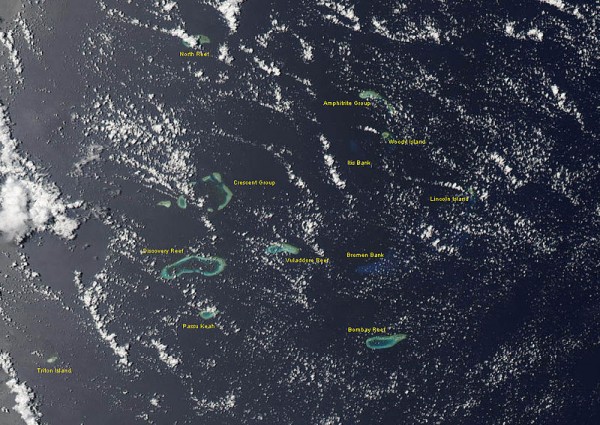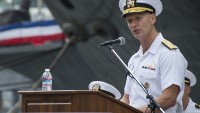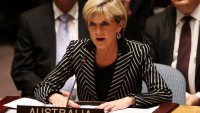Taiwan Confirms Presence of Chinese Missiles in Disputed South China Sea Island
| Carlos Castillo | | Feb 17, 2016 06:24 AM EST |
(Photo : Wikimedia Commons / NASA) A panoramic view of the Paracel islands in the South China Sea, where the Chinese government has reportedly deployed advanced surface-to-air missile systems.
Taiwanese defense officials on Tuesday confirmed the presence of advanced surface-to-air missiles on a disputed island in the South China Sea under the control of China.
The confirmation from Taipei came after Fox News issued a report about new civilian satellite images suggesting the presence of missile systems on an island claimed by both China, Vietnam and Taiwan.
Like Us on Facebook
The images from ImageSat International appear to show two batteries of eight surface-to-air missiles launchers and a radar system on Woody Island, part of the disputed Paracel island chain in the South China Sea. The images were reportedly taken last week.
"The Taiwanese defense ministry has learned of China's deployment of surface-to-air missiles on Woody Island, in the Paracel Islands," a statement from Taipei reads. "The Republic of China military is closely monitoring further development of the situation."
An unnamed US defense official also confirmed the "apparent deployment" of the missiles.
"Apparent Deployment"
China has controlled the Paracel island group since 1974, and considers it part of the country's Hainan province. But Beijing's authority over the area is being challenged by the governments of Vietnam and Taiwan.
Reports of the presence of Chinese missiles in the area went public just as US President Barrack Obama issued a call to all parties involved in disputes over the South China Sea to cease land reclamation and other activities that contribute to the militarization of the contested waters.
Obama made the entreaty at the conclusion of a US-led summit with leaders of the Association of Southeast Asian Nations (ASEAN) in California. It is unclear whether the US chief executive already knew about the missiles before he issued the statement.
When asked about the missiles, however, Navy Commander Bill Urban -- a spokesman for the Pentagon -- said the US has been keeping an eye on developments in the Paracels. "While I cannot comment on matters related to intelligence, we do watch these matters very closely," he said.
Responding to questions about the issue at a press conference held on Wednesday, Chinese foreign minister Wang Yi did not confirm or deny the deployment of the missiles, but said he thought it was an attempt by Western media to create stories.
"Self-Control"
The satellite images obtained by Fox News appear to show a pair of HQ-9 air defense arrays, a Chinese version of Russia's much-vaunted S-300 missile system. The HQ-9 "Red Banner" is said to be capable of shooting down aircraft within a range of 200 kilometers.
The missiles reportedly arrived on Woody Island in the past week. Images obtained separately indicate dredging and filling at two new sides in the Chinese-administered archipelago, and construction work on what analysts say is a helicopter base.
Taiwan's president-elect Tsai Ing-wen has noted the rapid escalation of tensions over the South China Sea in recent weeks. She appealed to all parties involved in the dispute over the contentious territory to exercise restraint.
"We urge all parties to work on the situation based on principles of peaceful solution and self-control," Tsai said after news of the presence of missiles on the disputed islands broke.
Rory Medcalf, who heads the National Security College at the Australian National University in Canberra, says reports of China's deployment of missiles to Woody Island are "sadly not surprising."
"This will further militarize tensions in the South China Sea," Medcalf told the Sydney Morning Herald. "It reinforces the view that China intends to exert growing control in these international waters, including potentially by declaring an air defense identification zone."
The South China Sea is a vital thruway for global commerce. The US Department of Defense estimates that around 30 percent of the world's ship-borne trade transits across the Asian waterway each year, including around $1.2 trillion in trade bound for the US and over $190 billion in exports from Australia.
TagsChina-Vietnam relations, China-Taiwan relations, US-China relations, Territorial disputes in the South China Sea
©2015 Chinatopix All rights reserved. Do not reproduce without permission
EDITOR'S PICKS
-

Did the Trump administration just announce plans for a trade war with ‘hostile’ China and Russia?
-

US Senate passes Taiwan travel bill slammed by China
-

As Yan Sihong’s family grieves, here are other Chinese students who went missing abroad. Some have never been found
-

Beijing blasts Western critics who ‘smear China’ with the term sharp power
-

China Envoy Seeks to Defuse Tensions With U.S. as a Trade War Brews
-

Singapore's Deputy PM Provides Bitcoin Vote of Confidence Amid China's Blanket Bans
-

China warns investors over risks in overseas virtual currency trading
-

Chinese government most trustworthy: survey
-

Kashima Antlers On Course For Back-To-Back Titles
MOST POPULAR
LATEST NEWS
Zhou Yongkang: China's Former Security Chief Sentenced to Life in Prison

China's former Chief of the Ministry of Public Security, Zhou Yongkang, has been given a life sentence after he was found guilty of abusing his office, bribery and deliberately ... Full Article
TRENDING STORY

China Pork Prices Expected to Stabilize As The Supplies Recover

Elephone P9000 Smartphone is now on Sale on Amazon India

There's a Big Chance Cliffhangers Won't Still Be Resolved When Grey's Anatomy Season 13 Returns

Supreme Court Ruled on Samsung vs Apple Dispute for Patent Infringement

Microsoft Surface Pro 5 Rumors and Release Date: What is the Latest?













